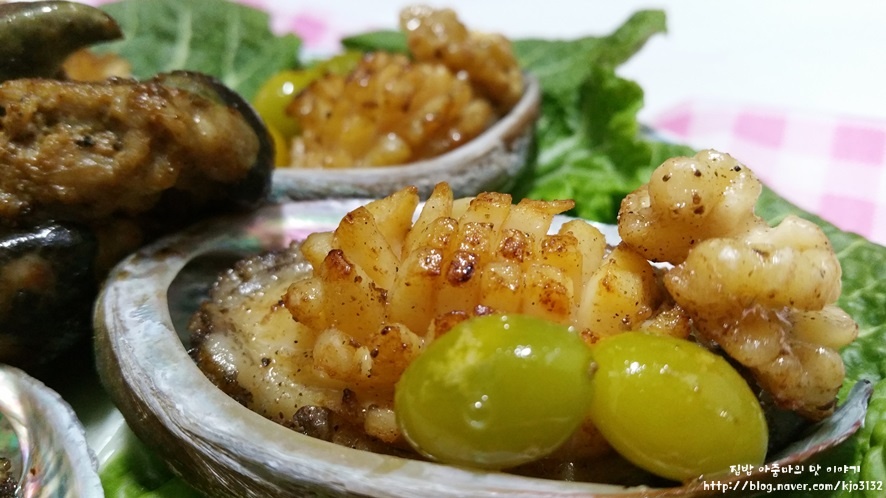Chewy and Tender! Recipe for Abalone Butter Roast, a Treasure from the Sea
Delicious Abalone Butter Roast with a Rich, Savory Flavor

When the weather gets chilly and you want to boost your family’s health, this is the perfect dish! Try making a flavorful abalone butter roast, known as the ‘ginseng of the sea.’ The abalone, slightly seared on the outside and tender inside, combined with savory butter, gingko nuts, and walnuts, creates an elegant dish. Everyone from children to adults will enjoy it, making for a happy family meal.
Ingredients- 5 fresh live abalone
- 1 piece unsalted butter (approx. 20g)
- 5-6 ginkgo nuts
- 3-4 walnuts
- A little canola oil or cooking oil
- 2 pinches black pepper
- 1 Tbsp sake or mirin
Cooking Instructions
Step 1
First, it’s important to clean between the abalone shell and flesh thoroughly. To remove the rough part on the abalone’s surface, sprinkle about 1/2 tablespoon of coarse salt and gently rub the abalone. This helps remove sticky mucus and thoroughly cleans off any stubborn dirt from the shell. Use a clean brush to scrub meticulously between the shell and the flesh.

Step 2
The easiest way to separate the abalone flesh from the shell is by using a spoon. Abalone has a round side and a pointed side; insert the pointed end of the spoon into the gap between the flesh and the shell and twist. This allows you to easily separate them without much effort. Using a spoon is also helpful when separating the flesh from the shell after it’s been removed.

Step 3
Another method is to briefly blanch the abalone in boiling water for about 10-20 seconds. This slightly cooks the abalone flesh, making it much easier to separate from the shell. After blanching, quickly rinse it in cold water and then detach the flesh. This method also helps prevent the abalone from shrinking when cooked.

Step 4
After separating the flesh, it’s time to remove the guts and the abalone ‘beak’. The hard beak is located at the bottom part of the abalone, corresponding to its mouth. Carefully cut out and remove the beak. Also, remove the green part, which is the abalone’s digestive tract. (If you enjoy the guts, you can leave them in for extra flavor!)

Step 5
This step involves scoring the abalone flesh to make it look appealing and help it absorb flavors better. On the rounded side of the abalone (opposite where the guts were), make diagonal scores. Be careful not to score too deeply. Aim for a criss-cross pattern. Many people score the front side, but scoring on the guts side helps prevent the abalone from distorting or shrinking when cooked.

Step 6
Peel the shells off the ginkgo nuts and walnuts before using. For ginkgo nuts, briefly blanch them in boiling water for about 1 minute, then rinse in cold water. The shells will come off easily. For walnuts, you can also blanch them in boiling water for 1-2 minutes to remove the skin, or simply use pre-shelled walnuts for convenience. Preparing them this way ensures they won’t burn when stir-fried with the abalone and will be enjoyed tenderly.

Step 7
Usually, ginkgo nuts can be shelled by lightly toasting them in a pan, but since we’re stir-frying them with the abalone this time, I briefly blanched them in boiling water and prepared them with the walnuts. This way, you can add the ginkgo nuts and walnuts to the pan while cooking the abalone, reducing hassle.

Step 8
Now, all the ingredients are prepped! Heat a pan over medium-low heat, add 1 piece of unsalted butter and about 1/2 tablespoon of canola oil (or cooking oil), and let it melt. Once the butter is melted, add the prepared abalone and start stir-frying. I also stir-fried the nutrient-rich guts along with it. (My husband doesn’t eat the guts, but I love their unique savory flavor, so I ate them all!)

Step 9
Place the abalone in the pan and sear it on both sides until golden brown. It’s important to cook it so the rich butter flavor permeates the entire abalone evenly. Once the abalone is partially cooked, add the prepared ginkgo nuts and walnuts and stir-fry them together. Roasting the nuts alongside adds a more savory and richer taste.

Step 10
Finally, sprinkle with 2 pinches of black pepper and add 1 tablespoon of sake or mirin to remove any fishy odors. Stir-fry quickly over high heat, and your delicious abalone butter roast is complete! The savory butter, chewy abalone, and the textures of the ginkgo nuts and walnuts combine to create a truly wonderful dish. Enjoy the best flavor immediately while it’s warm.




